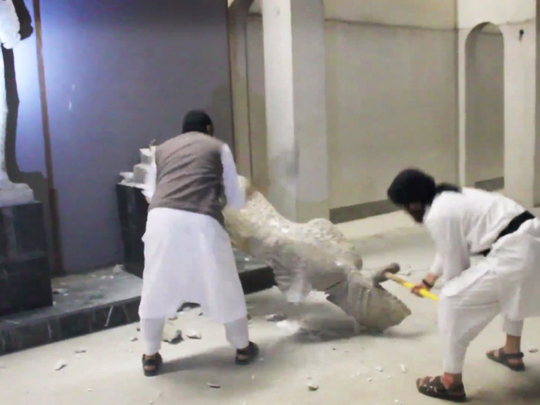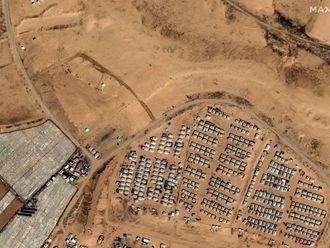
Los Angeles: Daesh wants the global community to know that there’s a new sheriff in town. So it wrecked a museum full of precious sculptures and on Thursday posted video of the vandalism on the Internet.
At least, that’s what their video wants you to think. The video quickly went viral, but there is reason for some skepticism.
Militants inside the Mosul Museum in northern Iraq are shown calmly going about the business of smashing 3,000-year-old statues from the ancient Assyrian empire and other historical dynasties. An on-camera narrator, citing verses from the Koran, confidently explains the destructive iconoclasm against pre-Muslim works of art as a necessary fulfillment of Islam’s dictum against the worship of false idols.
Earlier snuff videos from Daesh, show the beheading of soldiers, journalists and humanitarian aid workers. The new video purports to show nothing less than the beheading of an entire civilization.
The question is: Does it really? Or is the video, instead, a grotesque perversion of performance art, cynically designed to inflate the image of Daesh power?
However genuine their belief system, the chilling, five-minute video incorporates extensive fabrication. It may well be a carefully staged, falsified dramatic event performed to create an effective propaganda tool to achieve important Daesh goals.
Look closely, and most of the toppling statues shatter in clouds of dust. Apparently they are plaster replicas of ancient statues, not carvings in alabaster and other durable stone with which authentic imperial sculpture was made. Toppled stone would break in cleaner chunks.
Stone is an enduring material. Impressive examples of ancient Assyrian art are held in many major museums internationally, including the Los Angeles County Museum of Art. Five extraordinary alabaster reliefs from the inner walls of the palace of Ashurnasirpal II (883-859 BC) in modern-day Nimrud, just south of Mosul, have been among the collection’s preeminent works since LACMA acquired them in 1966.
From the Great Sphinx of Giza to the Lincoln Memorial in Washington, D.C., its use in monumental sculpture embodies power. It is meant to express aspirations toward permanence, sometimes vainglorious and sometimes noble. Obliterating a revered stone edifice says -- in no uncertain terms -- that radical change has arrived.
Visit the Getty Villa in Pacific Palisades and count the ancient Greek and Roman marble sculptures whose noses are smashed, their pagan claim to enduring ideal beauty whacked by subsequent armies of the self-righteous. That erasure is also why the Taliban blew up the 6th century Bamiyan Buddhas north of Kabul, Afghanistan, in 2001.
Stone is obdurate. Video is not. However, in YouTube culture digital art can be equally formidable. It spreads laterally and fast -- then lingers in the electronic ether, available for endless replay.
Because Mosul is a war zone under Daesh control, information on what actually happened at the museum is sketchy -- and will remain so for some time. A similarly chaotic situation followed looting of the Iraq Museum in Baghdad during the 2003 American-led invasion.
Baghdad’s museum is a prime repository of civilization’s ancient cultural heritage, traced to the earliest settlements in the Tigris-Euphrates region. Invading American troops secured Baghdad’s massive oil ministry with 50 tanks and round-the-clock sharpshooters but, despite advance pleas from scholars, left the art museum defenseless. News of what was stolen, damaged or safe took months -- and in some cases years -- to discover.
Britain’s Channel 4 television gave Daesh propaganda video to archaeologists to examine. Mark Al Taweel, an American scholar at the Institute of Archaeology at University College London, noted the modern iron rebar protruding from inside some of the smashed statues. It disproves their authenticity.
Cultural heritage
Nonetheless, the vandalism’s cultural insult strikes deep. The Iraqi people, Al Taweel said, “are taking the destruction of their cultural heritage -- their identity, essentially -- just as seriously as the beheadings.”
And that is the point: The video is an incitement for its viewers, a blunt provocation for them to act.
On one hand, it is a bombastic recruitment tool, which beckons the disaffected to join fundamentalist religious fanatics in their supposedly glorious adventure.
On the other, it is an outrageous stick with which to poke the bear -- including and perhaps especially the United States.
Important antiquities have certainly been damaged or destroyed, including a monumental Assyrian statue of a winged bull-man that stood watch at one of the 15 gates to Ninevah. (In the video it looks like a lamassu, a human-animal protective deity, at the Nergal Gate.) Nineveh, once the largest city in the ancient world and long since a storied ruin across the Tigris River from Mosul, has been one of the 12 sites listed since 2010 by the Global Heritage Fund as being on the verge of irreparable loss.
Public libraries are being ransacked, modern books and old manuscripts from the Ottoman Empire burned.












